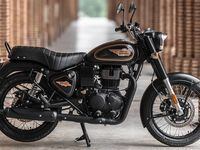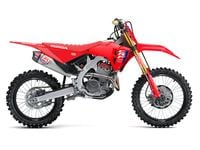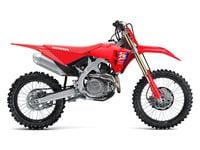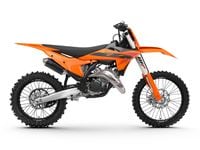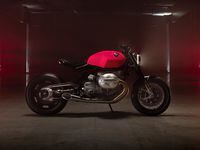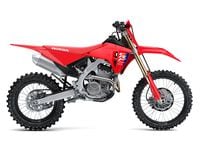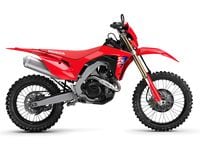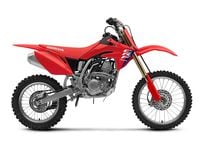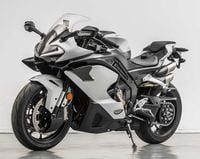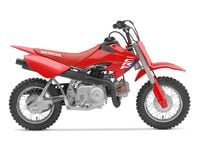Supermotos, remember them? Remember when almost all manufacturers were making bikes with no fairings, flat seats, big suspension, and sticky tires? And we were buying them, kidding ourselves that we would behave better or save our licenses by stepping off 1,000cc sportbikes onto lightweight singles that struggled to top 90 mph. A proper, competition-derived supermoto is pure, concentrated fun in the right environment.
And so there was the catch—on twisty, bumpy back roads, nothing could beat a supermoto for smiles, but get out onto more open terrain and they were doomed. Vibrations, wind blast, and crippling service schedules ruled out any of the hard-core supermotos for a lot of people. And manufacturers’ attempts to tame the supermoto often ended in bikes that, while still fun, were too heavy, too soft, and too muted to give that same raw thrill. Slowly, the supermoto craze went underground, with mainstream manufacturers looking to bigger, twin-cylinder variants to scratch that itch.
Except KTM. The Austrian manufacturer has forged a reputation for edgy bikes, for doing things differently, and so when everyone else stepped away from single-cylinder streetbikes, KTM stuck at it. Which brings us up to date, with this, the latest incarnation of the LC4 single-cylinder engine and the SMC R supermoto it forms the heart of.
The new KTM SMC R 690 has upped the game in terms of street supermoto machines. It's not like there were other bikes muscling in on its patch, competing for sales, but KTM has made significant changes for this update all the same. Two-thirds of the bike's components have been redesigned, with the intention of making the SMC R faster, more practical, and more accessible. And it will be coming to the States.
Let’s start with the best bit, the motor. To get 74 hp out of a 690cc single-cylinder engine is pretty damn special; to do so without it grenading every 5 miles is, frankly, witchcraft. The new power unit has a shorter stroke and larger bore, producing very similar power to the old one through the bottom and midrange, but then goes on to make an extra 7 hp at the top-end as the old motor starts to tail off. Keeping this power usable and not shaking your fillings out is a new balancer shaft positioned in front of the single cam in the cylinder head. On the transmission side, a power-assist slipper clutch gets those 74 horses into the gearbox, with a lighter lever action to give your left hand an easier time.
The chassis hasn’t escaped the attention of the engineers either; to cope with the extra power, the steel trellis frame has had a redesign to make it stiffer, and it’s now narrower around the headstock area improving steering lock. A new fuel tank increases capacity to 3.5 gallons. Elsewhere the chassis has been decorated with some top-spec shiny bits; fully adjustable 48mm WP Apex fork and WP Apex shock featuring separate high- and low-speed compression damping adjustment. A nice touch is that under the seat you’ll find a label with suggested suspension configurations for comfort, normal, and sport riding. The tools to carry out the adjustments are stowed in a neat kit behind the left radiator cowl. To haul in the new motor, the front brake has been upgraded to a hefty Brembo radial four-piston caliper biting down on a 320mm disc.
A serious amount of work has gone into upgrading the hard parts, the bits you can touch, but equal attention has gone into giving the new SMC R an up-to-date electronics package that far out-specs what you might expect on a supermoto. Sure, the instruments are as basic as it comes, sticking to a simple LCD display of speed and a few essentials. But the rider aids more than make up for that; proper, lean-angle-sensitive Bosch ABS and traction control mean that even when the conditions are moody, you can still push and still have fun with a safety net to save your collarbones.
The rider aids are set according to the riding modes—Street or Sport. Street gives more intervention from both ABS and TC, with anti-wheelie and anti-stoppie strategies in action. In Sport mode the throttle response is sharpened up and traction control and ABS intervention is backed right off, allowing you to slide the bike around a little more and wheelie. As with previous SMC R models, there is a dongle available in the PowerParts accessory range that opens up Supermoto mode for the ABS; this setting allows you to lock the rear wheel completely and stoppie as high as you like while still preventing front wheel lockups. And for full hooligan mode, you can switch ABS and traction control off altogether. A quickshifter takes care of gear changes, letting you click up and down the ratios without having to trouble the clutch. The final touch to the electronics is a little nod toward practicality: a USB charging port in the side of the front headlight cowl.
Rolling out onto mountain roads, you immediately feel the new engine’s effects. Well, actually, it’s what you don’t feel that is most noticeable—for such a big single-cylinder, the new 690 is impressively smooth. There is still a nice thrum to the engine, plenty of character there, but without making your fingers and eyeballs go blurry within the first mile. On tight, twisty roads, predictably the 690 is an absolute blast.
Barreling up to turns, stamping mercilessly down the gears, and pitching it hard on its side, you’ll be giggling like an idiot within seconds of the SMC R’s leaving the garage. The electronics only serve to encourage you, giving confidence to push even when you find yourself on suspiciously shiny looking road surfaces. When pushing hard, even the occasional mid-turn gravel patch couldn’t unravel the new chassis; it manages to be agile, yet forgiving when you inevitably overstep the mark.
One area that often highlights flaws in any supermoto is when you stop riding them like an idiot and try to have a nice, flowing ride. With long-travel suspension and dirt-bike roots, supermotos often rely on heavy braking to compress the fork and get the bike to turn nicely. When you try to turn in without heavy braking, say, just rolling off the gas or even tipping in on a neutral throttle, the front end on long-travel bikes can often feel vague. Thankfully, the SMC R avoids that trait and does actually work nicely when you’re not piling into turns like it’s the last lap of a race.
And on the subject of fixing age-old supermoto niggles, when you get a 690 on to the open road, it is really impressive. The sort of fast, flowing sections that would have less-powerful motards wheezing and vibrating themselves to pieces highlight just how well the new 690 goes at high rpm. With peak power at 8,000 rpm, the LC4 just keeps pulling for so much longer than a big single has any right to. Despite having a piston the size of a boxer’s fist, the 690 engine manages to be smooth and tractable throughout the rev range. Off the bottom, there’s plenty to punch the front wheel up into the air, and then the short-stroke motor keeps screaming on, pulling hard right up to the rev limiter. The result is a bike that can hang with pure supermotos in the tight stuff and still give trouble to bigger-capacity bikes once you’re out in the open. Some of the other riders on the launch were complaining of a few missed gears throughout the day, particularly on track, but the only hiccups I had with gear selection were more down to clumsy kicks at the lever on my behalf than the ’box itself.
The new KTM SMC R 690 really has moved the game for what can be achieved in a road-going supermoto in terms of performance and usability. If you’re not a fan of supermotos, then the 690 isn’t likely to change your mind. It still has a relatively small tank at 3.5 gallons, there is no wind protection, and you feel like you are set on top of it, rather than riding in it. But if you like your riding to be more fun than afar, you’ll be hard-pressed to find a bike more fun than this. It wants to wheelie everywhere; it spends its entire life hunting out mischief and dragging you along for the ride.
Riding an SMC R is like hanging out with that one crazy friend who always gets you into trouble. Whether you’re scraping pegs at a kart track or jumping flights of stairs, the 690 is hell bent on making you smile. Add that to a bike that you can ride to work every day and has the rider aids to soak up your over-enthusiasm and you have got one hell of a summer ahead of you. Thank KTM for keeping supermoto alive.
/cloudfront-us-east-1.images.arcpublishing.com/octane/UKVKTVU2REN3TE3RMSKHCBET6A.jpg)
/cloudfront-us-east-1.images.arcpublishing.com/octane/AZLY6MOXGYO5FTMMD27PVM73TU.jpg)
/cloudfront-us-east-1.images.arcpublishing.com/octane/MQ2ROSSKTO7XB2G5UFXHMBZEXA.jpg)
/cloudfront-us-east-1.images.arcpublishing.com/octane/JTZ7C2X4LNW7EDHXI7OX2U2BDM.jpg)
/cloudfront-us-east-1.images.arcpublishing.com/octane/24J4TXBPHPL2SY6F6RXQWYQ3XU.jpg)
/cloudfront-us-east-1.images.arcpublishing.com/octane/UL4FYTMTQ2U7IF7W5RLJJITDSI.jpg)
/cloudfront-us-east-1.images.arcpublishing.com/octane/2EVHJW6TH6AKVRMHJEY2DQNB7E.jpg)
/cloudfront-us-east-1.images.arcpublishing.com/octane/KAZ2DKTJXPYYOBA2YRJDE57MRE.jpg)
/cloudfront-us-east-1.images.arcpublishing.com/octane/ETIMRJM4V535TBGPCVFR6DNRPM.jpg)

/cloudfront-us-east-1.images.arcpublishing.com/octane/N575KB7BDZDPPJBRLZRG2ANHKI.jpg)
/cloudfront-us-east-1.images.arcpublishing.com/octane/T77HXRXV4NGKDNZODMSEIBRXPE.jpg)
/cloudfront-us-east-1.images.arcpublishing.com/octane/NKMM7V2P3BCSXAV6J56FKK67OU.jpg)
/cloudfront-us-east-1.images.arcpublishing.com/octane/SWQRQV27DNFA7LXGFI7FNFNGOQ.jpg)
/cloudfront-us-east-1.images.arcpublishing.com/octane/GYEXUJBV5JGQLLZNXO7KRVSTEY.jpg)
/cloudfront-us-east-1.images.arcpublishing.com/octane/MCWUSJJVJVG45P7QQG3WOXZR54.jpg)
/cloudfront-us-east-1.images.arcpublishing.com/octane/AJ4EFPH2CRDURDAB5LPEA2V2NE.jpg)
/cloudfront-us-east-1.images.arcpublishing.com/octane/LSDHIL22SZAFFPYLKP5ZXLJSIY.jpg)
/cloudfront-us-east-1.images.arcpublishing.com/octane/SH46HIOX4RELXLXF6AE3SFGH4A.jpg)
/cloudfront-us-east-1.images.arcpublishing.com/octane/JUZ52WFWLJGMNH7PGZNOKP3MUY.jpg)
